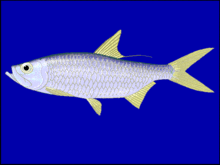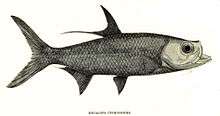Indo-Pacific tarpon
| Indo-Pacific tarpon | |
|---|---|
 | |
 | |
| Scientific classification | |
| Kingdom: | Animalia |
| Phylum: | Chordata |
| Class: | Actinopterygii |
| Order: | Elopiformes |
| Family: | Megalopidae |
| Genus: | Megalops |
| Species: | Megalops cyprinoides |
| Binomial name | |
| Megalops cyprinoides (Broussonet, 1782) | |
| Synonyms | |
| |
The Indo-Pacific tarpon, Megalops cyprinoides, also known as the oxeye herring or simply herring, is a relatively medium-sized species of tarpon.[1]
Description
In appearance, it is like the Atlantic tarpon, Megalops atlanticus: olive-green on top, and silver on the sides. The large mouth is turned upwards; the lower jaw contains an elongated, bony plate. The last ray of the dorsal fin is much longer than the others, reaching nearly to the tail. It is capable of filling its swim bladder with air and absorbing oxygen from it. Species in fresh water tend to be smaller than the saltwater species, growing just over 50 cm (20 in), while saltwater species grow over a 1 m (3.3 ft). They live an upwards of 44 years and mature within two. They complete their metamorphosis from their larvae stage in 10 days.[2]

Diet and behavior
They are an opportunistic feeder, feeding on smaller fish, crustaceans, and even plants rarely. In saltwater, they mainly feed on prawns and herring, but also many other small fish. In fresh water, no significant difference in their food habits is seen; they eat freshwater prawns and bony bream, mainly.[3]

The Indo-Pacific tarpon migrates between the open sea and inland rivers. As with all Elopiformes, it spawns, mainly offshore.[4] Juveniles of the species stay inshore and migrate to coastal areas while maturing to spawn. Typically, they spawn twice a year. At sea, the larvae migrate inland and are leptocephalic (flattened, transparent and eel-like). Unlike the barramundi, they are able to breed in fresh and salt water.[5]
They are found in depths to 50 m (160 ft), but are commonly found by the surface in shallow inshore waters. They inhabit coral reefs, mangroves, swamps, rivers, lakes, reservoirs, floodplains, and canals. In Papua New Guinea, they are reportedly found under large mats of Salvinia molesta.[6]
Distribution
The tarpon lives in many tropical areas of Australia in the tropical, coastal, and brackish waters of the Indo-Pacific oceans. in both freshwater and saltwater. They are widely distributed from Australia, Japan, and North Africa. Their population has deficient data on their population as their commercial landings and human disturbances are unknown, however they are known to be extremely common throughout their range. Over 300 specimens are found in museums.[1]
Captivity
This species has recently gained attention by predatory fish keepers though they have been sporadically imported in the past. Almost all imported tarpons are used in aquaculture.
References
- 1 2 Adams, A., Guindon, K., Horodysky, A., MacDonald, T., McBride, R., Shenker, J. & Ward, R. 2012. Megalops cyprinoides. In: IUCN 2013. IUCN Red List of Threatened Species. Version 2013.2. [www.iucnredlist.org]. Downloaded on 01 March 2014.
- ↑ Kulkarni, C.V. 1983. Longevity of fish Megalops cyprinoides. Journal of the Bombay Natural History Society 80: 230-232.
- ↑ Coates, D. 1987. Observations on the biology of the Tarpon, Megalops cyprinoides(Broussonet) (Pisces:Megalopidae) in the Sepik River, Northern Papua New Guinea.Australian Journal of Marine and Freshwater Research 38: 529-535.
- ↑ Leis, J.M. and Reader, S.E. 1991. Distributional ecology of milkfish, Chanos chanos, larvae in the Great Barrier Reef and Coral Sea near Lizard Island, Australia.Environmental Biology of Fishes 30: 395-405.
- ↑ Ley, J.A. 2008. Indo-Pacific Tarpon Megalops cyprinoides: A Review and Ecological Assessment. In: J.S. Ault (ed.), Biology and Management of the World Tarpon and Bonefish Fisheries, pp. 3-36. CRC Press, Boca Raton, FL.
- ↑ Chen, H.L. and Tzeng, W.N. 2006. Daily growth increment formation in otoliths of Pacific tarpon Megalops cyprinoides during metamorphosis. Marine Ecology Progress Series312: 255-263.
External links
Froese, Rainer and Pauly, Daniel, eds. (2005). "Megalops cyprinoides" in FishBase. 05 2005 version.